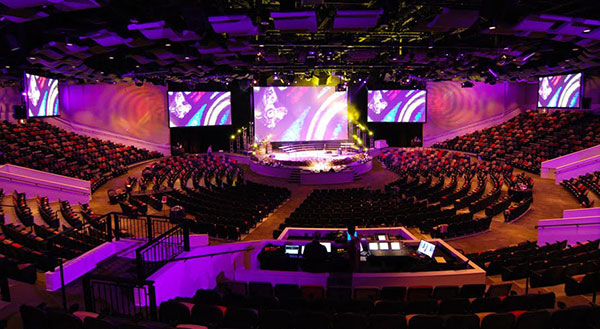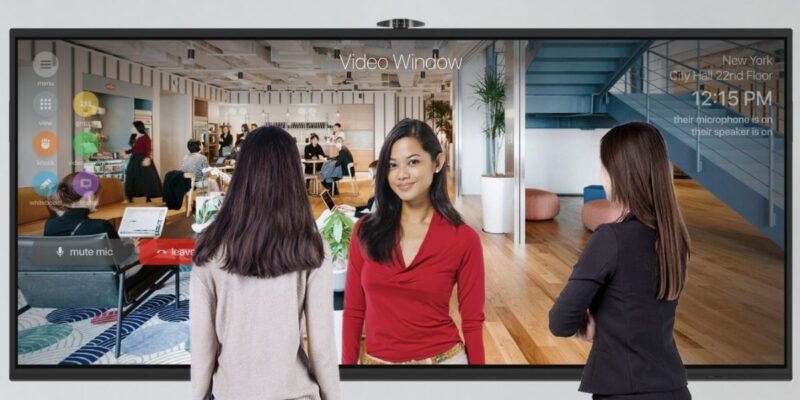InfoComm: Big Video: Churches See the Light

By Dan Daley
Special to InfoComm International
It’s sometimes hard to reconcile the putative mission of a church with what has become the technically sophisticated entertainment experience inside many of them. But irony hasn’t stopped many houses of worship from pursuing ambitious AV technology strategies in an era when video dominates media of all types. If anything, video technology has become more critical for churches, as the trend toward satellite locations continues to expand.
Today, many churches grow by opening new outposts in towns, cities, and states — in contrast to the late 20th century growth model that ushered in the rise of the mega church. These satellite churches sometimes adhere to the cookie-cutter model of secular retail, whereby new stores look like smaller versions of flagship locations. When it comes to growing churches, if the main sanctuary has three screens, so will the satellite locations. That way the lead pastor looks exactly the same on Sunday mornings, regardless of where parishioners receive the message.
“Whether they use ‘sneaker-net’ or live streaming, the ability to have the same pastor and the same sermon at each location is what gives the strategy its coherence,” says Gary Zandstra, director of sales and marketing for Parkway Electric, an AV integrator in Holland, Michigan.
The bottom line? More screens, more projectors, more video.
Changing Times
But there are several forks in the road as HOW video progresses. Most notably, many churches now are pondering their choice between conventional lamp-based projection and increasingly affordable and ever-larger LED/LCD video displays. As LCD screens blow past 90 inches, they become practical options for small and mid-sized churches, or in much larger sanctuaries, as the screens that flank big, center-projection systems.
And as their bezels get thinner, flat-panel displays also are being combined into video walls. Integrators say some churches are even embracing stackable LED cubes, capable of 1,300 or more lumens and controllable via Wi-Fi.
“The brightness of LED walls is a big attraction for churches because many of them have a lot of windows and have to deal with a lot of ambient light during services,” observes Zandstra.
Zandstra says that some churches may initially be put off by the cost of an LED panel-based video wall, which can cost as much as 40 percent more than conventional lamp-based projection. However, he says, customers also are quick to realize that LED screens don’t periodically need new projection lamps, which can cost hundreds of dollars each. In addition, lamp-based projectors generate heat, which can add to a church’s cooling bills.
“There’s a lower cost of operation that can offset the additional cost of LEDs to a significant extent,” Zandstra says, citing a recent project his company worked on where the client opted for a $50,000 video wall over a $30,000 projection system, after doing the calculations. “As the cost of LED panels comes down, more churches are looking at that option.”
Projection Pushes Back
However as a technology platform, video projection isn’t standing still in its efforts to win the hearts and minds of video-hungry churches. Laser-based light sources are quickly developing as an alternative for projection systems. Sony’s VPL-FHZ55 3LCD laser-light source projector, touted as the first of that kind when it was introduced earlier this year at a cost of $4,460, asserts 20,000 hours of operation for its laser. Roughly speaking, a conventional projector lamp might need to be replaced several times over that same span, at a cost of $1,500 or more.
That said, conventional projection still has scale on its side. While LED video walls can get as large as 100-plus feet, today’s projection technology increasingly is being used to map entire stages, creating virtual environments from video “paint.” Such projection-mapping solutions may be used for weekly services, but they’re especially useful for seasonal productions that might have required substantial amounts of physical scenery in the past. It’s what Chris Jordan, president and self-styled Chief Steward at Ft. Worth, Texas-based AV integrator Electro Acoustics calls “environmental worship,” which he credits with making churches less reliant on multiple screens and in the process keeping the focus on the pastor.
“Mapped video makes the experience more immersive and that makes the technology less distracting,” he says. “Instead of the video as boxes on the stage, the video becomes part of the stage.” Jordan says projection is being used to “paint” scrim and other architectural elements of the stage, allowing it to change as the nature of the sermon or music changes.
Brian Poole, production manager for Elevation Church, a multi-campus church in the Charlotte, North Carolina, area, says projection mapping has become standard practice at his church since it first employed the technology to create virtual scenery on stage for an Easter pageant in 2012. Now, Elevation Church uses Green Hippo’s Hippotizer HD media server, MadMapper video-mapping software and Millumin video management software to manage a multi-projector array. Not only does the solution, which comprises projectors ranging from 3,500 to 20,000 lumens, perform video mapping, it also drives the left-center-right projection-screen configuration used at most of the church’s 11 campuses.
The video projection that Elevation Church uses for its weekly services has become so bright that it’s essentially merging with venues’ lighting, a phenomenon that touring entertainment productions have reported in recent years. In fact, many of the church’s video elements are now fired from the lighting console, with the video and lighting directors collaborating on the color palette for music and other effects.
“We have to watch out that none of this becomes a distraction from the message,” says Poole. “That’s something we find ourselves discussing a lot.”
LED Catches On
But as flexible as projection has become, it’s apparent that LED is gaining mindshare in the HOW technology universe. As Poole speaks about his experience with video projection and mapping, Elevation Church has also been in the process of specifying its first LED video wall, in conjunction with its partnering AV integrator LMG of Orlando, Florida, which he says imports its own LED panels from overseas.
The expectation is that the three conventional projection screens at Elevation’s largest location will be replaced by a single large LED wall — one that can be reconfigured in any way imaginable using a server.
“You have the IMAG [image magnification] images and other content across a single wide-format screen,” Poole says. “You can put any image or piece of content anywhere at any time. You don’t have to assign certain things to certain screens. And it’s bright enough that we feel sure the pastor will be seen easily from 150 feet away.”
Chris Jordan at Electro Acoustics, which has already installed an LED video wall at one church and expects to integrate more soon, says the introduction of the technology will render aspect ratios meaningless. “We’re moving toward an environment in which we no longer have to be limited to conventional [aspect ratio] formats,” he says. “That’s going to give a tremendous boost to creativity.”
The future, HOW integrators say, must also include video on personal devices, from smartphones to tablets. How that concept will integrate with the sense of shared experience that defines the word “congregation” remains to be seen. But video’s pervasiveness in the larger culture suggests it will find a way.
This column was reprinted with permission from InfoComm and originally appeared here.
Image via Technical Innovation





